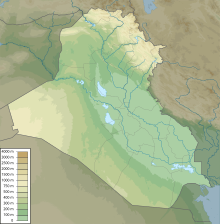| Anu ziggurat | |
|---|---|
 | |
| Coordinates | 31°19′27″N 45°38′14″E / 31.32417°N 45.63722°E |
| Constructed | Uruk period |
| Type | Ziggurat |
| Height | 13 metres (43 feet) |
Ubaid period (c. 6500 – c. 4000 BCE)
editEarly Uruk phase (c. 5000 – c. 4000 BCE)
editUruk levels XIX to XII (c. 5000 – c. 4000 BCE)
editKullaba
editThe Anu District was originally called 'Kullaba' (Kulab or Unug-Kulaba) prior to merging with the Eanna District. Kullaba dates to the Eridu period when it was one of the oldest and most important cities of Sumer. There are different interpretations about the purposes of the temples. However, it is generally believed they were a unifying feature of the city. It also seems clear that temples served both an important religious function and state function.
Uruk period (c. 4000 – c. 3100 BCE)
editOld and Middle Uruk phases (c. 4000 – c. 3500 BCE)
editUruk levels XII to VI (c. 4000 – c. 3500 BCE)
editAnu ziggurat
editUnlike the Eanna district, the Anu district consists of a single massive terrace, the Anu Ziggurat, dedicated to the Sumerian sky god Anu. The Anu Ziggurat began with a massive mound topped by a cella during the Uruk period (ca. 4000 BC), and was expanded through 14 phases of construction. These phases have been labeled L to A3 (L is sometimes called X). The earliest phase used architectural features similar to PPNA cultures in Anatolia: a single chamber cella with a terazzo floor beneath which bucrania were found.
Processional stairs
editIn addition to this temple the Anu Ziggurat had a monumental limestone-paved staircase, which was used in religious processions. A trough running parallel to the staircase was used to drain the ziggurat.
Late Uruk phase (c. 3500 – c. 3100 BCE)
editUruk levels VI to III (c. 3500 – c. 3100 BCE)
editStone building
editUnder the northwest edge of the ziggurat an Uruk VI period structure, the Stone Temple, was discovered. The Stone Temple was built of limestone and bitumen on a podium of rammed earth and plastered with lime mortar. The podium itself was built over a woven reed mat called ĝipar, which was ritually used as a nuptial bed. The ĝipar was a source of generative power which then radiated upward into the structure. The structure of the Stone Temple further develops some mythological concepts from Enuma Elish, perhaps involving libation rites as indicated from the channels, tanks, and vessels found there. The structure was ritually destroyed, covered with alternating layers of clay and stone, then excavated and filled with mortar sometime later.
Jemdet Nasr period (c. 3100 – c. 2900 BCE)
editFinal Uruk phase (c. 3100 – c. 2900 BCE)
editUruk levels III to I (c. 3100 – c. 2900 BCE)
editWhite temple
editIn phase E, corresponding to the Uruk III period (ca. 3000 BC), the White Temple was built atop of the ziggurat. The White Temple could be seen from a great distance across the plain of Sumer, as it was elevated 21 m and covered in gypsum plaster which reflected sunlight like a mirror. For this reason it is believed the White Temple is a symbol of Uruk's political power at the time.
Altar
editLater history
editGallery
editSee also
editReferences
editNotes
editCitations
editSources
editBibliography
editJournals
editExternal links
editGeography
editLanguage
edit- Black, Jeremy Allen; Baines, John Robert; Dahl, Jacob L.; Van De Mieroop, Marc. Cunningham, Graham; Ebeling, Jarle; Flückiger-Hawker, Esther; Robson, Eleanor; Taylor, Jon; Zólyomi, Gábor (eds.). "ETCSL: The Electronic Text Corpus of Sumerian Literature". Faculty of Oriental Studies (revised ed.). United Kingdom. Retrieved 2022-09-23.
The Electronic Text Corpus of Sumerian Literature (ETCSL), a project of the University of Oxford, comprises a selection of nearly 400 literary compositions recorded on sources which come from ancient Mesopotamia (modern Iraq) and date to the late third and early second millennia BCE.
- Renn, Jürgen; Dahl, Jacob L.; Lafont, Bertrand; Pagé-Perron, Émilie (2022) [1998]. "CDLI: Cuneiform Digital Library Initiative" (published 1998–2022). Retrieved 2022-09-23.
Images presented online by the research project Cuneiform Digital Library Initiative (CDLI) are for the non-commercial use of students, scholars, and the public. Support for the project has been generously provided by the Mellon Foundation, the National Science Foundation (NSF), the National Endowment for the Humanities (NEH), the Institute of Museum and Library Services (ILMS), and by the Max Planck Society (MPS), Oxford and University of California, Los Angeles (UCLA); network services are from UCLA's Center for Digital Humanities.
- Sjöberg, Åke Waldemar; Leichty, Erle; Tinney, Steve (2022) [2003]. "PSD: The Pennsylvania Sumerian Dictionary" (published 2003–2022). Retrieved 2022-09-23.
The Pennsylvania Sumerian Dictionary Project (PSD) is carried out in the Babylonian Section of the University of Pennsylvania Museum of Anthropology and Archaeology. It is funded by the NEH and private contributions. [They] work with several other projects in the development of tools and corpora. [Two] of these have useful websites: the CDLI and the ETCSL.
